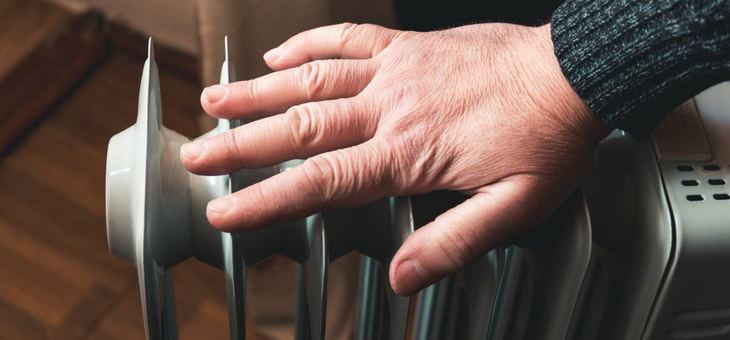Australian households are using 16 per cent more electricity during the coronavirus pandemic than at the same time last winter, leading to concerns about ‘energy poverty’.
Figures released by energy company Jemena showed the impact of more residents working from home, with business energy consumption down 12 per cent on 2019.
Sara Wilkinson, professor of sustainable property at the University of Technology Sydney, told Nine that more than 30 per cent of Australians faced energy poverty because they were spending more time at home and electricity prices continue to increase.
Australian electricity prices are among the most expensive in the world, according to the International Energy Agency.
Australian Property Institute chief executive Amelia Hodge told Nine that older Australians and people on low incomes were most affected by the high cost of heating and cooling their homes, which often lack energy efficiency.
Joel Dignam, chief executive of advocacy group Better Renting, agreed that many people on lower incomes spent a greater proportion of their income on utilities.
“So, these people either end up with unaffordable utility bills, or they end up living in a freezing home to try to cut costs. This is dangerous and a risk to their health.”
Mr Dignam said the pandemic had worsened energy poverty because people were spending more time working, studying or simply staying at home.
“This means that there is more need to heat the home, pushing up energy bills,” he said. “It also means that if the home is cold, people are exposed to it for longer.”
How to heat your home more efficiently
In the average home, heating accounts for 40 per cent of energy costs. You can reduce the energy used for heating your home by minimising heat loss and improving efficiency.
Consumer watchdog CHOICE and Sustainability Victoria advise the following to save on your power bill:
– Eliminate draughts. Make sure windows and doors are well sealed. Use self-adhesive draught seal tape and door snakes, and close off rooms you don’t need to heat. (If you’re using a portable gas heater, you need some ventilation.) Seal small cracks and gaps with a caulking gun, and larger gaps with expanding foam.
– If you own your residence, insulate the ceiling. Ideally, walls and floors should also be insulated. Rugs can provide some useful insulation on a hard floor. Insulating your ceiling, walls and floor will help prevent the heat generated by your heater from escaping. It’s the most effective way to improve the energy performance and comfort of your home. Compared to a non-insulated home, a fully insulated home can save 40–50 per cent in heating costs.
– Curtains and blinds help keep the warmth from escaping through glass windows and doors. When your heater is running, close curtains and blinds to reduce heat loss through your windows (unless you have warming winter sunshine coming through your windows). Close-fitting, heavy curtains with a box pelmet will significantly reduce the amount of heat loss through windows during winter months.
– Set your thermostat efficiently. In living areas, set your thermostat between 18°C and 20°C. Every degree higher can increase your heating costs by around 15 per cent. Your thermostat should be in living areas where you spend most of your time. Protect your thermostat from draughts and heat sources, such as direct light, so that it accurately records the temperature. Don’t place your thermostat on an external wall.
– Install ceiling fans to distribute heat. Reversible ceiling fans can redistribute the hot air which builds up near high ceilings. During summer, they push air down to provide a cooling breeze. But when reversed in winter, they pull air up from ground level, mix it with the warmer air at ceiling level and push it down the sides of the walls, so if you have a ceiling fan with a reverse-direction option, consider using it at a low speed to help circulate the hot air more evenly through the room without creating a downward breeze.
– Dress according to the weather conditions outside. If it’s cold, wear a jumper indoors.
– Only use your system when you need it.
– To reduce standby power, turn off your entire heating system when you go on holidays and during summer. This is different depending on your system. If you have a gas heater, turn off the pilot light, if it has one. If you have plug-in heaters, turn off them off at the switch. If you have an air conditioner, turn off the circuit breaker in the switchboard.
– Clean your reverse-cycle air conditioner’s filters to keep it running effectively and consider whether it needs a service.
– If you have an older ducted heating system, have your ductwork checked when the heater is serviced. Ductwork can develop holes and splits, connections can become loose and animals can crush them, significantly reducing the efficiency of the system.
– Keep outlets and return air grilles clear. Ducted heating systems have floor or ceiling mounted outlets that blow hot air into rooms’ return air grilles, which suck in the air to be reheated in a central heating unit. Make sure you don’t block off the pathway between the heating outlets and the return air grille. Keep curtains and furniture clear of outlets and the return air grille, so air is free to flow. You can purchase air deflectors for your ducted heating systems. These can be placed on top of the floor vents to deflect the heated air away from windows and under furniture. Some floor vents have in-built deflectors.
Are you using more energy because you are at home more often? Is your power bill more expensive?
If you enjoy our content, don’t keep it to yourself. Share our free eNews with your friends and encourage them to sign up.
Related articles:
https://www.yourlifechoices.com.au/retirement/retirement-income/is-deflation-good-news-for-your-budget
https://www.yourlifechoices.com.au/health/covid19/what-to-do-when-the-market-turns-nasty
https://www.yourlifechoices.com.au/retirement/living-in-retirement/affluents-cruise-cashstrapped-lose

